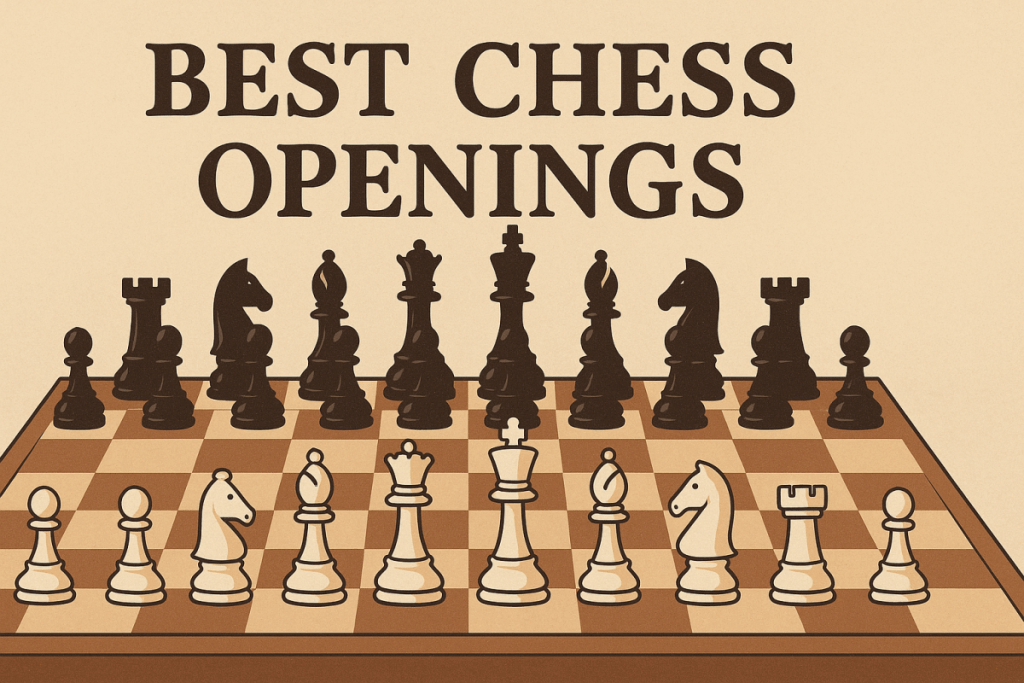The beginning of a game is crucial in chess. It prepares your plan, pawn structure and general strategy. An opening typically occurs in the first 10–15 moves, and here they focus on three main principles:
- Control over the center
- Rapid development of pieces
- King safety (usually via castling)
Sadly, most beginners get into bad habits very early by repeatedly moving one piece or taking their queen out too soon and ignoring to develop.
A solid basis in opening theory is necessary for success as well, because you can only play well against your opponent from the start if you don’t allow yourself to be taken by surprise.
Picking the Right Chess Openings
What’s the best opening for you depends on how you play. Are you aggressive or cautious? Do you like tactical chaos or strategic clarity?
Here’s what to consider:
- Play Style: Tactical vs. positional
- Experience: For novices, an opening must be straightforward and based on principle.
- Time Control: Blitz might have you playing openings with traps, but in classical games sound theory is a necessity.
You don’t have to commit hundreds of lines to memory. Concentrate on principles and plans.
Best Chess Openings for White
- Ruy Lopez
1. e4 e5 2. Nf3 Nc6 3. Bb5
A staple that puts Black’s position under central control and enduring pressure. As embodied by Bobby Fischer and Magnus Carlsen. - Italian Game
1. e4 e5 2. Nf3 Nc6 3. Bc4
Promotes quick pawnstorms and potential king-side attacks. - Queen’s Gambit
1. d4 d5 2. c4
Resurrected by the recent Netflix series, this opening is rich in strategic ideas and center domination. - English Opening
Move order: 1. c4
Versatile, adaptable to many systems. Perfect for the variety-seeking players. - King’s Gambit
1. e4 e5 2. f4
Aggressive, romantic, and speculative. Perfect for blitz, pick-up games.
Best Chess Openings for Black
- Sicilian Defense
1. e4 c5
Creates asymmetrical positions with winning chances for Black. Variations such as the Najdorf and Dragon are sharp and heavily analyzed. - French Defense
1. e4 e6
Solid structure and counterattacking potential. - Caro-Kann Defense
1. e4 c6
Known for its solidity and harmonious development. - King’s Indian Defense
1. d4 Nf6 2. c4 g6
Aggressive, with counterplay against White’s center. - Scandinavian Defense
1. e4 d5
Direct and surprising.
Aggressive Chess Openings
- Smith-Morra Gambit
1. e4 c5 2. d4 cxd4 3. c3
Sacrifices a pawn for rapid development and attacking chances. - Vienna Game
1. e4 e5 2. Nc3
Tricky ideas and traps. - Danish Gambit
1. e4 e5 2. d4 exd4 3. c3
Extremely aggressive, giving away pawns for quick initiative.
Solid and Safe Openings
- London System
1. d4 and 2. Bf4, or 2. Nf3 and 3. Bf4
System-based, very popular at all levels. - Slav Defense
1. d4 d5 2. c4 c6
A classical defense to the Queen’s Gambit. Provides solid structure. - Petrov’s Defense
1. e4 e5 2. Nf3 Nf6
Symmetrical and ultra-solid.
Chess Openings for Beginners
- Giuoco Piano
1. e4 e5 2. Nf3 Nc6 3. Bc4 Bc5
Encourages sound development and tactics. - Four Knights Game
1. e4 e5 2. Nf3 Nc6 3. Nc3 Nf6
Symmetrical and simple. - Scotch Game 1. e4 e5 2. Nf3 Nc6 3. d4
Sharp but easy to learn.
Life isn’t long: concentrate on ideas, not deep variations.
Advanced Chess Openings
- Sicilian Najdorf – Razor-sharp and deeply analyzed.
- Grünfeld Defense
1. d4 Nf6 2. c4 g6 3. Nc3 d5
Dynamic counter to White’s center. - Nimzo-Indian Defense
1. d4 Nf6 2. c4 e6 3. Nc3 Bb4
Strategic and complex.
Notable Chess Games and Their Openings
- Fischer’s Ruy Lopez mastery.
- Kasparov’s aggressive Sicilians.
- Carlsen’s flexible opening approach.
Chess Opening Traps
- Scholar’s Mate – A simple mate all beginners should know.
- Fool’s Mate – The fastest mate, but rare in real play.
- Blackburne Shilling Trap – A common trap in the Italian Game.
Opening Theory vs. Practice
Theory matters, but understanding ideas is more valuable than rote memorization. Try to grasp the point of each move.
Memorization Tips
- Use spaced repetition apps (e.g. Anki)
- Focus on patterns, not move orders
- Analyze model games
- Practice online and review results
Common Opening Mistakes
- Neglecting development
- Developing the queen too soon
- Ignoring center control
- Overextending pawns
- Playing without a plan
How Grandmasters Prepare
Grandmasters use databases, engines, and assistants for preparation. They study deep lines, novelties, and prepare physically and mentally.
FAQs
How many openings should I know?
Start with one for White and one for Black, then expand.
Should I learn openings or ideas?
Ideas are more important; memorization comes later.
Aggressive vs. defensive openings?
It depends on your style. Aggressive ones create tension, solid ones are stronger in long games.
Is the Queen’s Gambit good for beginners?
Yes. It instruct on pawn structure, space and positional play.
How to get good at chess openings?
Play online, analyse games with an engine and study masters’ games.
Conclusion
Understanding the best chess openings is not just about learning moves by heart. This is about vision, self-belief and adjusting to your opponent. Experienced or newbie –there’s always room for more knowledge. Then you can pick openings that suit your style and practice them, and before you know it, you’ll be getting better.

